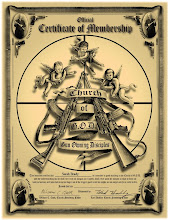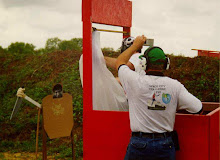So, to follow up on my previous post about guns not fitting, I'll add a little explanation. Others have been through it before and do a great job such as Brigid. We also have a much more in depth explanation up at the KRTraining website. I'll throw in my two cents worth as well.
The main issue with gun fit is almost always problems reaching the trigger properly. With the gun properly centered in your hand, the barrel should line up with the soft tissue web in between your thumb and index finger and the long bones of your forearm. It should all make a nice straight line to help you control and direct recoil properly. With your hand gripping the gun in this position, you should be able to put your trigger finger on the trigger it should make a right angle with the trigger so when you press it, the trigger moves straight back and you are not pressing the trigger and gun to one side or the other. Along with this fit, your trigger finger needs to have space between it and the frame and grip of the gun so that when you press the trigger you are not applying pressure to the side of the gun pushing it off target when you shoot. If your hands are too big for the gun, you can often compensate for fit by curling your trigger finger to make sure that you are applying pressure to the trigger straight back or using more finger instead of the first pad to press the trigger. Again, so that the motion is in line with the barrel and not pushing the gun off to one side or the other. One common issue with the longer finger and big hands is that if the shooter is not familiar with gun fit and the geometry of their finger and the trigger, they end up using too much finger and pull the gun off to the side and off target instead of making sure the pull is straight back.
The more typical problem is when the gun is too large for the hand. With the gun gripped properly, you cannot get your finger far enough forward and still bend it so that it makes a right angle with the trigger. This is REAL common with double action and DA/SA guns. The trigger pull is so long that you end up with the tip of the finger on the side of the trigger and putting pressure on it not only pulls it back but also pushes the the gun off to the side when you try to shoot. If the gun is just marginally too large, you may be able to get your finger on the trigger properly, but your finger drags on the frame and puts pressure on the side of the gun when you shoot. Again leading to misses off to the side.
There are still two other considerations here. One is reaching the controls. Trying to get to the mag release, slide stop (IT IS NOT A SLIDE RELEASE), and any thumb safety or de-cocker the gun may be equipped with. While 1911's are easy to setup for a shooter with small hands to get on the trigger properly, there is still an issue with reaching the slide stop and being able to engage it to lock the slide open. This may be cured with an extended slide stop and the mag release can be pressed with the left thumb as you are taking your hand off the gun reaching for a replacement mag. (seen it done this way with some regularity very quickly by the better half)
The second consideration is the abilit of the shooter to manually operate the slide. A big part of this is technique. (This is often where a male instructor suffers from BFS and takes the gun away form a female shooter and does this for them) Many people are shown to pull the slide and push the frame out in front of them. This is a weak way of doing it using the forearms to do the work. By turning the shooter and keeping the gun pointed downrange, you move the gun in closer to the chest and by gripping the slide in a clamshell with the off hand, you can push with the long muscles in the chest and arms to make use of the stronger muscles. Also using a snap of a motion ratehr than gently trying to push the slide back will often give an advantage to getting the slide all the way back.
With the right technique, people can overcome some fit problems but there are some physical limitations that flat out require a different gun or modification to an existing gun and people need to recognize and understand these if they really want to get better with their shooting. We had a coule examples this weekend where shooters were having problems and simply changing out the gun to one that fit made a huge improvement to their performance.
Go forth and shoot well!
Subscribe to:
Post Comments (Atom)





No comments:
Post a Comment